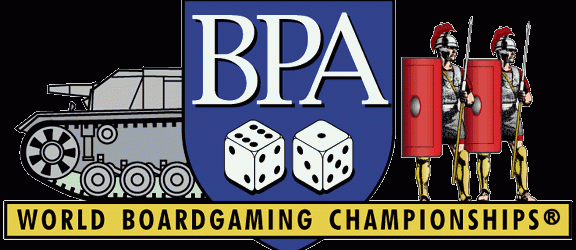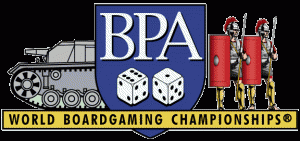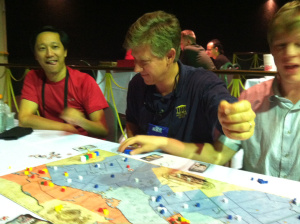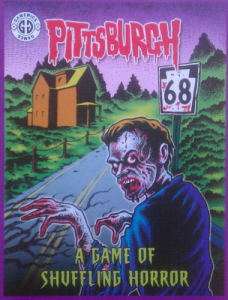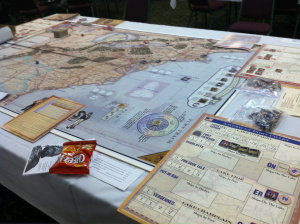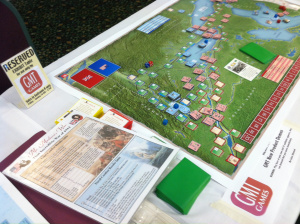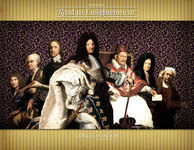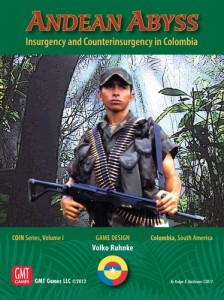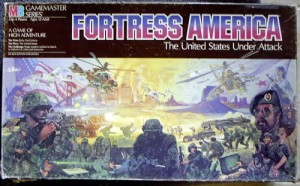By Fred Manzo
World Boardgaming Championship (WBC) 2012
If I could only go to one convention a year it would be the World Boardgaming Championship (WBC) in Lancaster, Pennsylvania.
While WBC doesn’t have everything you’d find at the bigger cons, like Origins or Gen Con, it does have everything you’d want if you were designing a convention from scratch. That is, while there weren’t any collectible card games or people dressed in costumes, there were loads of new games, a large lending library, play-test versions of upcoming releases, tournaments of the old favorites, outsized open gaming areas and plenty of game designers ready to discuss their latest projects.
Plus, there were enough dealers to let everyone browse through a wide selection of wargames – not something you see at every con. In total, I’d say there were about 20 or so dealers, which was more than enough to overflow the area allotted to them last year.
And all this generates a sense of energy you just don’t find elsewhere. In bigger conventions, for example, wargaming gets overwhelmed by a flood of Euros and novelty games (Pizza Theory anyone?), while at the smaller ones, publishers simply don’t make the same effort.
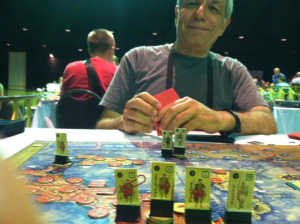
Gary playing Carthage in a game of Hannibal: Rome vs Carthage. The item in the foreground is not a red paperclip but the proconsul Nero’s sash of office.
In any event, I’d say there were about 1,000 attendees this year, with a 50/50 split between Euros and wargames in one form or another. That is, the large ground floor hall was packed with wargaming, the open gaming Dinner Theater area was split 70/30 Euros to wargames and the two medium-sized rooms were all Euros all the time. Of course, I’d have preferred more wargames, but with a hobby this small you take what you can get. After all, where else would you see a 3’ by 8’ table (with spotlights!) in the main lobby of a hotel highlighting Victory Games old The Korean War? Now, I’d call them spotlights, others might call them goose-necked desk lamps, but who’s in charge of the spin around here anyway?
WBC 2012 – Upfront tournament
And, of course, there are the tournaments, which ran from the precons the weekend before through the entire convention. For the stout-hearted that’s 8 or 9 days of solid gaming. Although, I’ve heard that the few people who do stay the enter course end up needing a vacation from their summer vacation.
“A World at War”, tournament table
So let’s say the con really starts mid-week. That’s 5 days of great gaming for a $70 entrance fee or $14 a day. And, as a “day” of gaming runs from 9 in the morning to 1 in the morning, we got our money’s worth, believe me.
Just about the only thing that was missing was a flea market.
Actually there was a pre-con flea market on Tuesday, but as the majority of attendees arrived later in the week, it wasn’t really an option for most.
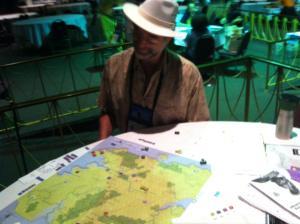
The game designer, John Poniske (of Mr. Licoln’s War fame) playing the ATO game “Boudicca: The Warrior Queen” by Richard Berg.
But there were plenty of designers, developers and publishers, such as Uwe Eickert (the publisher of Strike of the Eagle). Volko Ruhnke (designer of Andean Abyss), Hermann Luttmann (In Magnificent Style), John Poniske (King Philip’s War), Mark H. Walker (World at War: Blood and Bridges) and James Terry (5 Minute Football). GMT was also there, as was Academy Games, Valley Games, Grognard Games, Against The Odds (ATO), Lock ‘n Load Games, Ferkin Games (aka Columbia Games) and Victory Point Games, which when you think about it is a greater concentration of game companies than what we saw at Origins, a convention that is easily 10 times bigger than WBC.
Though, regrettably, not everything worked perfectly. The air conditioning, for example, in the tournament hall seemed to have been on the fritz, so most of the designers moved to the open gaming hall in the dinner theater. But that was just about the only glitch.
As a measure of how successful the convention was in the eyes of the participants, the Lancaster Host hotel is already booked solid for WBC 2013!
But if you are thinking of going next year – and I’d encourage everyone to give it a try – don’t let that stop you as there are 3 or 4 other hotels within walking distance.
So what games did we see?
Well, we looked at a prototype of Hermann Luttmann’s upcoming game on the second day of Gettysburg, called Hammerin’ Sickles. (And who said there is no humor in wargaming?) I think I’ll be playtesting it in a few weeks, so I’ll try to keep everyone up on how things develop.
Academy Games:
We also checked out 1775 – Rebellion, the new game from designers Beau Beckett and Jeph Stahl. It’s the next release in Academy Games 1812: The Invasion of Canada series. This time there are 4 factions: American Regulars, British Regulars, Colonial Militia Rebels and Colonial Militia Tories. The Native Americans are controlled by the first faction to enter their home territory and the reinforcements appear in a colonial capital if one player controls every area in that colony. It sort of reminds me of the reinforcement mechanism in Hannibal: Rome vs. Carthage. The game’s map runs from Georgia to Maine and its cards include foreign help, with the Hessians and the French even getting their own dice.
1775 – Rebellion has been sent to the printer and should be in stores in about 3 months. It’s $60 on pre-order.
In addition, we got to play 1812: The Invasion of Canada with Uwe Eickert and his son, Gunther. Although they weren’t able to convince me the game was balanced, they did win as the Americans in a marathon session that lasted until 1:30 in the morning. I didn’t really accomplish much of anything this time as I played as a member of a team and was consistently out voted on the best strategy. The next time I’ll try it mano-a-mano.
I did, however, have a chance to talk to Uwe Eickert about his latest edition of Awakening the Bear. According to Uwe he’s added artwork, streamlined the rules, made the start-up quicker and balanced the scenarios. I believe he’ll even give you a mug with a $ 70 pre-order.
A playtest version of John Poniske’s game “A Viking”
We also tried John Poniske’s new 5- player game A’ Viking. But that one will be harder to describe. The version we playtested was practically complete but while I know Academy Games was giving it serious consideration, they may want to convert it into a two player game.
So for what it’s worth, the prototype took an intriguing look at the Viking invasions of Saxon Britain around the time of Alfred the Great.
Think of it as 1812: The Invasion of Canada with taxes, border raids, back-stabbing, 4 Saxon kingdoms and a Viking faction lurking in the background. There are hits and Command Decision results on the various dice, but there are no flee results.
The inevitable black, gray, white, brown, yellow and green cubes represent Viking warriors, Viking peasants, Saxon peasants, various Saxon men-at-arms and gold plus Welsh, Cornish and Scottish non-player borders tribes.
Its turn sequence was triggered by a chit pull, as was the tax segment, which includes players buying more cards, forts, peasants, men-at arms, traitors and discount gold (which count as VPs at the end of the game).
The Saxon factions represent the kingdoms of Northumbria, Mercia, Wessex, and a fictional “Combined Kingdom” along the east coast made up of Kent, Essex and Sussex. Every kingdom is divided into 10 provinces that each generates a gold piece during tax season. Either a fifth player runs the Vikings or you can let the system run them itself.
The game comes with a map that shows Monasteries, Mints, Cathedrals, swamps, mountains or forests and covers the British Isles from southern Scotland through Cornwall. However, Ireland and the Continent are not included.
One of the games more interesting features is its “traitor” mechanism. You see your kingdom comes equipped with its very own turn-coat, who can be bought from under your nose by any other player (and, obviously, without your permission). Now you can stop all this treachery by using some of your limited funds to buy up your kingdom’s traitor counter. Of course, you could also save your resources and hope for the best, but that would only give one of your sometimes allies a chance to undermine one of your border forts through treachery prior to launching an invasion against you. (Traitors cancel the defensive benefits of forts, so their purchase is the first sign of a Saxon invasion, I.E., buy a traitor, use him to annul the defensive benefits of a frontier fort and then invade your former ally’s homeland).
But as traitors are, by definition, people who value money more than loyalty they can also be bought from under your neighbor’s noses by someone else just as easily as they were bought from under yours. This, obviously, is a big clue that many of your neighbors are not nice people, although this being the Dark Ages, you really should have known this.
Each of the 4 Saxon players has a deck made of 8 movement cards and three special cards. The specials might allow them limited sea movement, or they might generate a temporary truce, produce some gold or even recruit a few extra troops. On the other hand, the movement cards activate Saxon groups, with each moving one or two spaces. Unfortunately, some of these cards come with footnotes that either activate Welch, Cornish or Scottish non-playing raiders or trigger Viking card play. So the Saxon kingdoms must either play the Viking footnoted cards early and let the Vikings give them headaches throughout the game or they save their “bad” cards for the endgame and see a tidal wave of Vikings pull out a last minute victory. Tough choices.
So while A’ Viking starts off as an expansion area movement game, it quickly turns into an anti-Viking game. For if the Saxons gang up against the centrally located kingdom of Mercia under the theory that the weakest player should go to the wolves first, they’ll simply have one less strong ally to fight off the Vikings hordes when they inevitably come ashore.
From our point of view the only thing A’Viking needed was to give Merica, the central kingdom, a little extra help to fend off its ravenous neighbors in the early going and it would be ready to publish. Perhaps something as small as giving it two or three extra starting forts would have been enough. But I believe the game has gone back to the drawing boards.
GameWick Games:
We also came across Larry Wickman’s Pittsburg 68, a new beer–and-pretzels Zombie game. But then again is there any other kind?
In this one each player controls the usual group of survivors, including the “kid brother,” “the nurse” and “the bartender”, as they hunt for weapons and tools, while they are in turn hunted by packs of Zombies. One player starts off controlling the first Zombie throng and if he manages to wipe out a group of survivors, their player switches side. The Zombies win by eliminating all the humans before the deck runs out.
Pittsburg 68 comes with cards, dice and support, or “spport,” markers, but no board.
I played a game of it for an hour or two when we got back. We managed to get about halfway through before calling it a night. The humans seemed ahead at that time, but we really didn’t play at a competent enough level to come to any opinion. Perhaps we just needed more beer? But we did have enough fun to give it another try, so I might be able to provide more information on it in the future.
Treefrog Games:
We also found time to play Martin Wallace’s Waterloo and looked at his Gettysburg game, which basically uses the same system. They were outstanding, though Waterloo did seem to have a small glitch in its rules. But that might have just been us. Anyway, our French player used “juggernaut tactics,” in that he would deliberately overstack his forces, pay the small penalty and then proceed to blow away the British in an adjacent area.
You see each unit absorbs 6 hits before being eliminated. As the stacking limit is 3 units per area and the overstacking penalty is only one extra hit per overstacked unit, the French could place, say, 15 units in an area – which is 5 times the stacking limit – allow two of their lowest value units to be eliminated and then proceeded to blow away the British in an adjacent area at 4 to 1 odds. However, I later learned that there’s errata that attempts to fix this problem. So this might all be a non-issue for experienced players.
Anyway, the system uses area movement with infantry, artillery and cavalry figures. Waterloo, in particular, allows for hits to accumulate in an area via hit cubes and permits infantry to drop into defensive formations, including squares. Activations are controlled by your opponent secretly pulling a numbered tile. So, for example, while you might start a flanking movement with your enter left wing, only your opponent knows how far you will get before your turn ends. The same basic system is used in Martin Wallace’s Gettysburg, though I’ve heard it includes a hard and fast 3 unit stacking limit – So no more juggernaut tactics for Harvey. Overall, however, I was impressed.
Clash of Arms:
While I didn’t get a chance to play Kevin McPartland and Jerry Shiles’ Amateurs To Arms, it was set up. Unfortunately, the version I saw was in the tournament room (no A/C). So while it looked good no one was around to show it off.
GMT:
The neighboring table also had GMT’s Mr. Madison’s War spread out. It’s on their P500 list and covers just about the same area as Academy Games 1812: The Invasion of Canada although in slightly more detailed fashion, with lake control using ship counters and a reinforcement schedule. I gave it a quick glance but I wasn’t there long enough to come to any conclusions.
Conquistador Games:
On Friday we took a look at a new game in the dealer’s area (with A/C) by Dirk Knemeyer called The Road to Enlightenment. So I got a better overview of it than some of the other releases. By the way, its publisher, Conquistador Games, used the online Kick-Starter system to get it noticed.
It did look interesting, although it really didn’t seem to be any type of wargame as the idea behind it is for players to become the most prestigious ruler in 17th century Europe. As I understand it, each player takes the role of a European monarch such as William III of England, Peter the Great, Louis XIV, Phillip IV of Spain, Leopold of the Holy Roman Empire and Charles XII of Sweden.
It also comes with luminary cards covering famous people of the era, which drives the game and helps these rulers gain prestige. Each of these cards is rated for the ability of people such as Isaac Newton to boost their ruler’s reputation in Science, Knowledge and Ideas, Religion (the religious factions are only listed as Catholic and “Anti-Catholic”), Wealth (the creation of money and taxes), Politics and Military (how good these luminaries were at leading men in battle?)
The game includes a mounted map of Europe and uses blocks for country control. It also employs a point-to-point movement system. Now, while I never got to try it out, I was told that experienced players can finish it in 2 hours, while newbies might take as long as 4.
GMT Games:
We also played Andean Abyss with James Terry, the designer of 5 Minute Football, an app for your I-phone (“It’s not Words with Friends, It’s Football with Enemies!”). But I’m not really sure we were playing Abyss correctly, as only one of us had some experience with the rules. So I’ll hold back reviewing this game until the usual suspects give it the full treatment next month.
By the way, only Andean Abyss pre-orders were available at WBC, all the regularly ordered copies will be released in a few weeks.
Histogames:
We got a look at Maria by Richard Sivel, the second game in the Friedrich series. They both have a subtle pseudo-supply system based on a playing card deck and areas labeled with its suits: Hearts, Diamonds, Spades and Clubs. The guys playing it told us that the random event cards in Maria were toned down versions of those used in Friedrich (one of which had Czarist Russia dropping out of the war).
As Maria looked every bit as interesting as Friedrich, I’m thinking of getting a copy for myself.
Fantasy Flight Games:
One of the last games we managed to play was the new edition of Fortress America. This time they made things easier for the Western Invaders by adding two new cities, Las Vegas and Colorado Springs, and I think moving Denver closer to the coast. Plus, they allowed mobile units to transport infantry. This, in particular, is a big deal for the Western Invaders. But it was necessary as I‘ve heard the U.S. won about 70 percent of the time in the old Milton Bradley version.
In addition, Fortress America now has cards for the invaders. They can get either 8 reinforcements as normal or 5 reinforcements plus a powerful card. Some players felt that these cards alone might unbalance the game towards the invaders, but only further game play will settle the issue. The American’s cards, by the way, were practically the same, despite the fact they included a card that was made somewhat stronger and a new card.
The components, however, are all first rate and the game comes with built-in variants, including helicopter borne infantry movement and new invasion beach overlay pieces. Interestingly, the combat dice no longer have numbers, but instead use hit symbols. The balance issues aside, I’d say an enjoyable game just got that much better.
Conclusion:
So, fun was had by all, the Lancaster Host’s booked solid for 2013, the dealer area, while small, was packed and everyone left WBC happy. What more could you ask?


